Ever stumble upon a secret garden that makes you feel like you’ve stepped into a fairy tale?
It’s like being in Narnia without the talking animals—or maybe just the raccoons. I’ve crafted my own magical woodland garden, bursting with native plants and vibrant coral pink Pulmonaria.
Cozy nooks tucked between ferns beckon for a good book, while water features splash their way into the hearts of friendly pollinators. I often find myself playing explorer, discovering delightful surprises every time I stroll my winding paths.
Doesn’t that sound thrilling?
But hey, isn’t it a bit overwhelming, too?
Designing My Dream Garden: Lessons from Nature
One spring, I decided to dive into a weekend garden overhaul, inspired by my love for nature. Armed with a shovel and my questionable DIY skills, I transformed a dull patch of grass into a whimsical haven. Choosing organic shapes rather than rigid lines turned out to be an A+ decision.
Adding a butterfly bush, fragrant lavender, and a quaint stone bench made my space come alive. I find solace in the buzzing bees and fluttering butterflies. Sure, there’s chaos in nature, but that’s part of its charm, right? It taught me that sometimes messiness creates the most memorable beauty.
Quick Takeaways
- A meandering pathway design using organic shapes invites exploration and harmonizes with the landscape.
- Incorporating whimsical decorative elements like fairy houses and vibrant sculptures sparks curiosity and imagination.
- Layered vegetation and diverse native plants create inviting habitats for pollinators and enhance biodiversity.
- Cozy seating areas surrounded by lush greenery provide tranquil spots for relaxation and contemplation.
- Strategic lighting and focal points add a magical ambiance, extending the garden’s charm into the evening.
Embracing Natural Plant Diversity
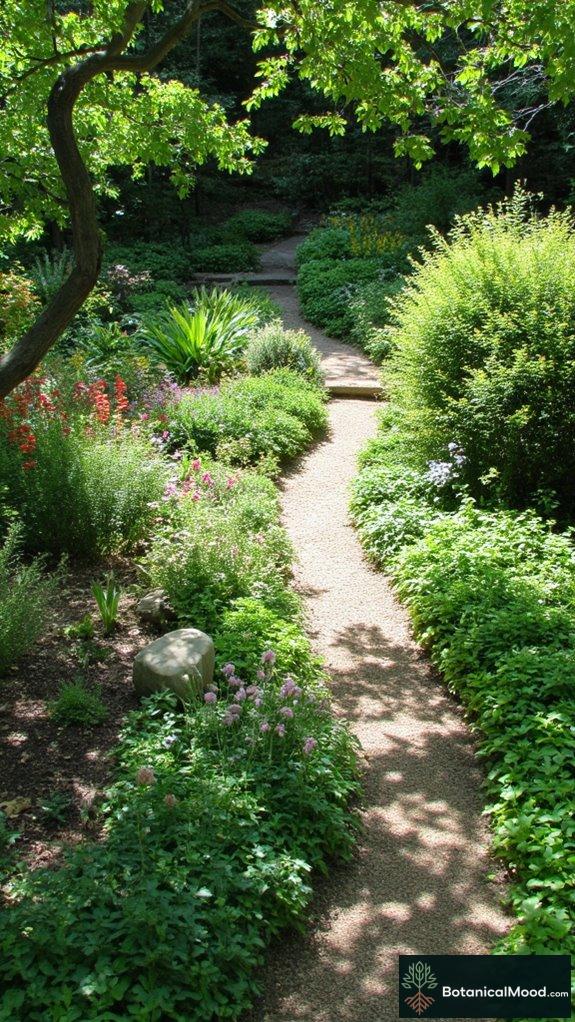
Embracing natural plant diversity isn’t just a trend; it’s an essential practice that transforms our gardens into vibrant ecosystems.
By intentionally selecting plant companions that thrive together, I’ve witnessed how these living entities elevate both beauty and functionality.
Seasonal changes create dynamic visual poetry, as blooms change with the time of year, inviting pollinators and supporting wildlife.
Seasonal shifts weave a tapestry of life, inviting pollinators and nurturing vibrant ecosystems throughout the year.
I often choose native species, which adapt seamlessly to local conditions, ensuring sustainable growth.
This conscious approach not only nurtures my woodland garden but also enhances its resilience; in fact, cultivating native gardens actively supports local pollinator populations, fostering a balanced ecosystem.
Join me in celebrating this complex dance of life; our environments deserve nothing less than holistic flourishing.
Designing Winding Pathways for Exploration

Designing pathways that weave through a woodland garden invites exploration and enhances the overall experience of the space, transforming simple strolls into enchanting journeys. I find that the right choice of pathway materials, from rustic gravel to elegant flagstone, can set the tone, guiding visitors seamlessly. When considering your design, explore inspiration from:
- Organic shapes that mimic nature’s contours
- Varied surface textures for sensory engagement
- Subtle lighting to extend the experience into dusk
- Strategic focal points that draw the eye
- Natural borders with native plants for cohesive aesthetics
Creating curved pathways that flow with the landscape can foster a sense of harmony and encourage deeper connections with the environment.
Each winding path leads not just to new sights but deeper connections with the natural world.
Creating Cozy Seating Areas in Nature

There’s something inherently comforting about having a cozy seating area nestled within a woodland garden, inviting moments of respite amidst nature’s beauty.
Imagine integrating rustic benches, crafted from reclaimed wood, into your design, creating cozy nooks that beckon you to linger longer. Surround these spaces with lush ferns and soft moss, enhancing the atmosphere of tranquility.
Layering in soft cushions, perhaps in earthy tones or vibrant prints, can add a touch of modernity, balancing nature with innovative design. As I cultivated Botanical Mood, I aimed to inspire such harmonious escapes, allowing each visitor to find their perfect spot for relaxation in a magical woodland retreat. Additionally, incorporating elements of country chic aesthetics can enhance your garden’s character while keeping it grounded in rustic charm.
Incorporating Whimsical Decorative Elements

Incorporating whimsical decorative elements can transform a woodland garden into an enchanting wonderland, where every glance reveals a new delight.
Imagine the charm infused by:
- Delightful fairy houses nestled among the roots
- Fantasy sculptures that spark curiosity and ignite the imagination
- Vibrant toadstool stools and benches for whimsical seating
- Artistic trellises adorned with colorful climbing plants
- Twinkling string lights strung between trees to create a magical glow
These additions not only enhance aesthetic appeal but also invite a narrative that captivates visitors, capturing the essence of nature and creativity.
This reflects the vision that inspired my own journey with Botanical Mood.
Enhancing Serenity With Water Features
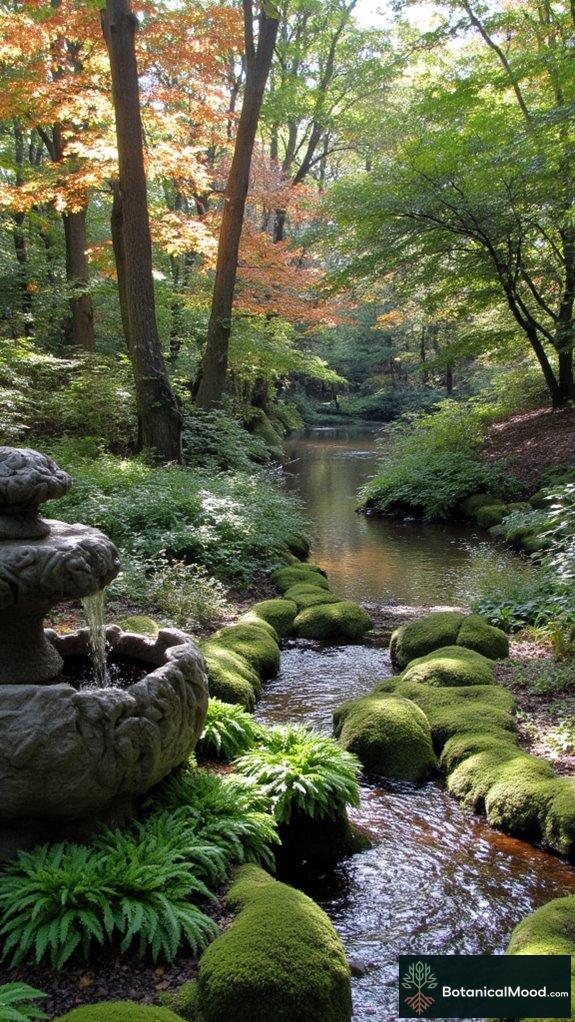
Water features, with their soothing sounds and shimmering reflections, can greatly elevate the tranquil ambiance of a woodland garden, seamlessly expanding the enchanting atmosphere created by whimsical decorative elements.
I often find myself captivated by tranquil ponds, perfect for reflecting the sky, while gentle streams meander gracefully through the scenery, adding a dynamic element that enchants the senses.
Soothing fountains create focal points, inviting visitors to pause and absorb the serene beauty all around. Reflective pools, surrounded by lush greenery, not only enhance the visual allure but also encourage an intimate connection with nature.
These innovative additions transform gardens into a dreamscape of peace and harmony.
Cultivating a Sustainable and Wildlife-Friendly Garden

As I explore the art of cultivating a sustainable and wildlife-friendly garden, it’s clear that creating an ecosystem rich in biodiversity isn’t only beneficial for local fauna but also enhances the overall beauty of the environment.
Cultivating a wildlife-friendly garden enriches biodiversity and enhances the beauty of our environment.
To achieve this, consider the following innovative approaches:
- Embrace native plantings that thrive in your region
- Create diverse wildlife habitats using layered vegetation
- Incorporate water features to attract pollinators
- Use organic mulches to retain moisture and improve soil health
- Design inviting spaces with varied colors and textures
These elements harmoniously coexist, fostering a vibrant garden sanctuary teeming with life, just as I envisioned when developing Botanical Mood.
Organic Pathways in Woodland Gardens

Creating organic pathways in woodland gardens not only enhances the aesthetic appeal but also fosters a seamless blend with the surrounding natural environment. I find that using sustainable materials like shredded leaves, wood chips, and bark chips allows for comfortable walking while promoting soil health. Winding paths made from organic mulch invite exploration, integrating with the area’s native flora. Additionally, using natural materials for paths guarantees water flows naturally, preserving ecosystem balance.
Natural Paths and Habitats

While exploring the complex relationship between natural paths and habitats, I’ve found that these elements are essential in crafting a cohesive woodland garden that not only serves as a sanctuary for various fauna but also enhances the experience for garden visitors.
Crafting a woodland garden intertwines natural paths and habitats to create a sanctuary for wildlife and enhance visitor experiences.
- Mossy trail aesthetics evoke tranquility.
- Enchanting forest nooks invite exploration.
- Diverse plant selections support wildlife.
- Pathways stimulate sensory interactions.
- Layered habitats create microclimates.
Organic Shapes and Flow
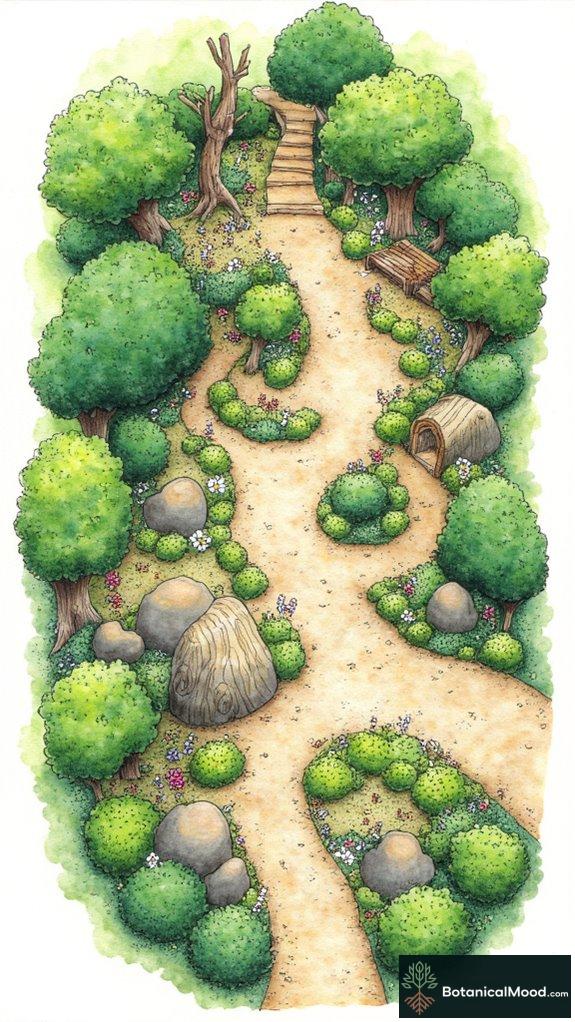
Organic shapes in garden design naturally inspire a sense of tranquility, infusing the surroundings with fluid lines and gentle curves that echo the undulating forms of nature.
I find that integrating organic silhouettes creates a harmonious composition, inviting exploration and interaction.
Employing rounded, mounding shrubs juxtaposed with cascading groundcovers enhances visual depth while introducing varied natural textures. Plant selection plays a crucial role in enriching these organic forms, allowing for meandering pathways that effortlessly guide the eye through the scenery.
It’s all about rhythm, as the balance of contrasting heights cultivates an enchanting aura, a principle I embrace through Botanical Mood to inspire woodland enthusiasts seeking innovative design solutions.
Whimsical Plant Arrangements

Whimsical plant arrangements can transform a garden into a magical narrative, where every bloom contributes to an enchanting story.
Transform your garden into a magical storybook where each bloom adds to the enchantment of nature’s narrative.
By incorporating playful arrangements that blend colors and varying heights, we create a tapestry rich in interest and depth.
- Embrace contrasts with broad hosta leaves and delicate ferns.
- Layer blooms from snowdrops to exotic Erythroniums.
- Mix native Virginia bluebells with exotic Arisaema for intrigue.
- Utilize ground covers that weave through taller perennials.
- Incorporate vibrant accents like coral pink Pulmonaria for whimsical pops.
Additionally, using native plants not only enhances the aesthetic but also supports local wildlife, enriching the garden’s ecosystem.
Together, these elements infuse our woodlands with the charm of a fairy tale, inviting exploration and joy.
How To Design Natural Woodland Garden Themes
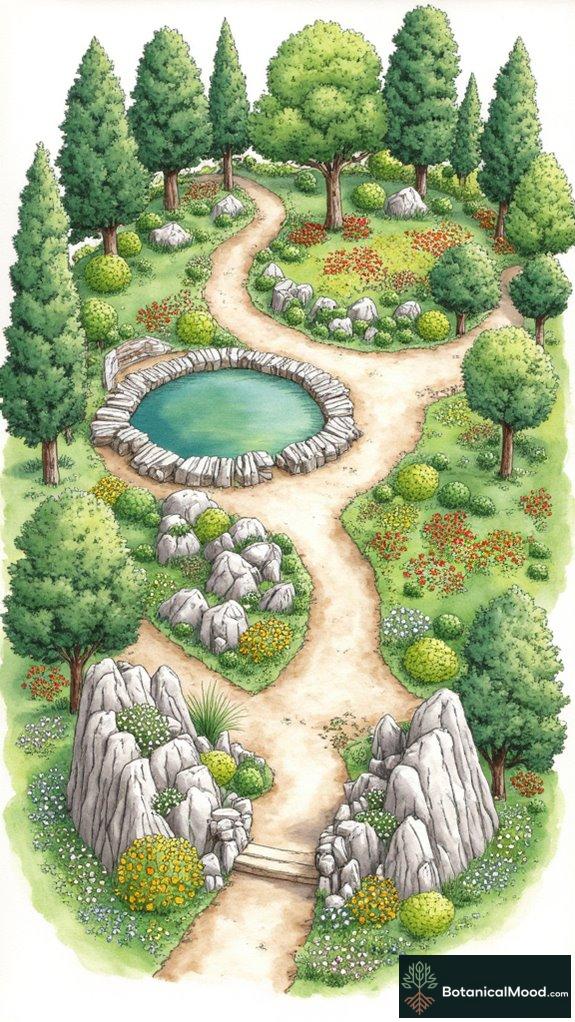
Designing a natural woodland garden theme requires an understanding of your terrain’s intrinsic beauty and potential. I focus on working with existing topography, preserving natural elements like rocky outcrops and established trees to serve as eye-catching focal points. By creating layered textures with upper canopy trees, mid-level shrubs, and diverse groundcovers, I craft dynamic plant communities rich in seasonal variations. Using native, shade-loving species optimizes ecological compatibility, while meandering paths of natural materials harmonize with the woodland aesthetics. This intentional design fuels my passion for gardens, where each detail enhances the overall beauty and tranquility amidst nature’s embrace. Naturalistic gardening emphasizes partnership with nature and encourages a wild spirit, making my garden a sanctuary for both flora and fauna.
Meet the Garden’s Visionary
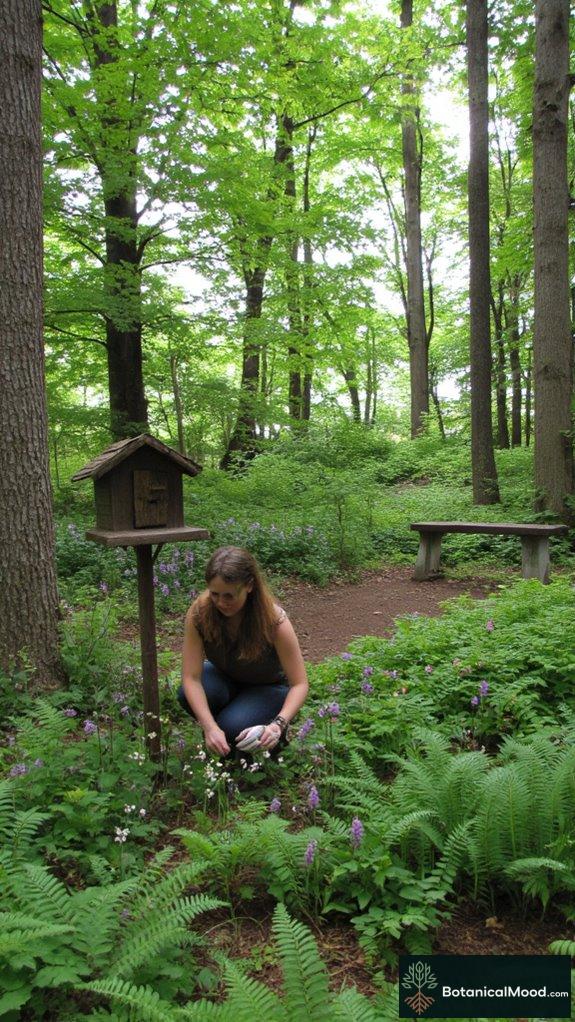
Jane Thompson hails from Asheville, North Carolina. Her lifelong passion for nature and experiences exploring the Appalachian woods ignited her desire to create a magical woodland garden that harmonizes beauty and ecology.
To achieve her vision, Thompson undertook a meticulous design process involving extensive research on native plants, seasonal aesthetics, and wildlife needs. She collaborated with garden designers and utilized sketching software, like SketchUp, to accurately translate her whimsical ideas into a cohesive plan that meticulously considered sensory engagement. Biodiversity is vital to enhancing the habitat for insects and wildlife within her garden design.
In the construction of her garden, Thompson employed tools from brands like DeWalt and Fiskars, while incorporating accessories such as decorative birdhouses from Evergreen Garden.
She also consulted with local horticulturists to select the ideal plant species, thereby ensuring the garden’s success and sustainability.
Renowned Landscape Architects

As I explore the world of renowned terrain architects, it’s striking how their innovative designs shape the very essence of our outdoor experiences.
These masters understand geographical features and design principles, crafting spaces that resonate with nature’s spirit.
- André Le Nôtre’s symmetric allure at Versailles
- Frederick Law Olmsted’s urban park transformations
- Thomas Dolliver Church’s textured California gardens
- Peter and Martin Wirtz’s geometric naturalism
- Terremoto’s ecological, low-water designs
Each architect redefined environments, introducing texture, color, and sustainable practices, reflecting beauty while fostering ecological synergy in our gardens, which is why I embraced sharing perspectives at Botanical Mood.
Garden Design FAQ
What Are the Best Native Plants for a Woodland Garden?
For a woodland garden, I highly recommend selecting shade tolerant plants that flourish naturally in native ecosystems.
Consider using ferns, like the complex Lady Fern or the elegant Maidenhair Fern, alongside wildflowers such as Bluebells and Trilliums.
Incorporating native shrubs, like serviceberry, adds vibrant seasonal interest.
Focusing on native plant selection not only enhances biodiversity but also creates a serene beauty right in your backyard, embodying the whimsical spirit of a woodland escape.
How Do I Maintain Moisture for Moss Growth?
To maintain moisture for moss growth, I soak the substrate thoroughly, ensuring a humid habitat for happy, healthy moss.
I prefer sustainable watering methods like using rainwater or creating a simple irrigation system with drip hoses. Mulching with organic materials retains moisture while providing essential nutrients.
By crafting a cool, shaded environment, I cultivate a thriving backdrop for this verdant wonder.
Explore botanicals with me as I shape my very own woodland dream.
Can I Create a Woodland Garden in a Small Space?
Absolutely, you can create a woodland garden in a small space!
I’ve found that vertical gardening and layering plants maximizes limited areas beautifully. Using small space solutions like container planting can give you lush ferns, delicate hostas, and vibrant shade-loving perennials.
Brands like Proven Winners offer compact varieties perfect for urban gardening. Incorporating elements like moss and decorative stones enhances texture and depth, transforming any area into a serene miniature woodland retreat.
What Types of Seating Are Safe for Outdoor Use?
When it comes to outdoor seating, I prioritize durability and style.
Weather-resistant furniture, like teak or aluminum, promises longevity while offering an elegant touch to any garden. Brands such as Fermob and Kettler create aesthetically pleasing designs that withstand the elements.
Incorporating cushions made from UV-resistant fabric enhances comfort without compromising on safety. Choosing the right outdoor furniture transforms your garden into a serene retreat, allowing for moments of tranquil reflection amidst nature’s beauty.
How Can I Attract Specific Wildlife to My Garden?
To attract specific wildlife to my garden, I incorporate inviting wildlife habitats, such as native plants that provide food and shelter.
I strategically place bird feeders filled with high-quality seeds to lure vibrant species. A water source, like a small pond or birdbath, enhances the allure, ensuring wildlife visits regularly.
Share Your Own Garden
Creating my woodland garden dreamscape has been a joyful journey. I blend diverse plants to enhance beauty and health while designing paths, cozy spots, and calming water features. Each element invites exploration and elevates the experience of nature’s charm.
I’d love to hear about your own experiences with garden design. What elements have you incorporated that resonate with you?
Feel free to share photos of your garden and how you’ve crafted your space. I’m excited to see your creativity!
References
- https://bluestem.ca/perennials/15-enchanting-forest-garden-ideas-to-transform-your-backyard/
- https://homedesigns.ai/go/woodland-garden-ideas/
- https://www.rhs.org.uk/garden-inspiration/design/inspiring-woodland-gardens
- https://www.youtube.com/watch?v=hEPqZ93zQvw
- https://brentandbeckysblog.com/blogs/news/ideas-for-a-woodland-themed-garden
- https://www.struckequipment.com/these-8-woodland-garden-ideas-could-help-you-create-a-stunning-backyard/
- https://www.jacksonandperkins.com/blog/garden-blogs/five-woodland-garden-ideas/b/woodland-garden-ideas/
- https://www.gardendesign.com/landscape-design/woodland-garden.html
- https://www.gardendesign.com/landscape-design/garden-paths.html
- https://www.monrovia.com/be-inspired/design-a-lush-woodland-garden.html

Leave a Reply